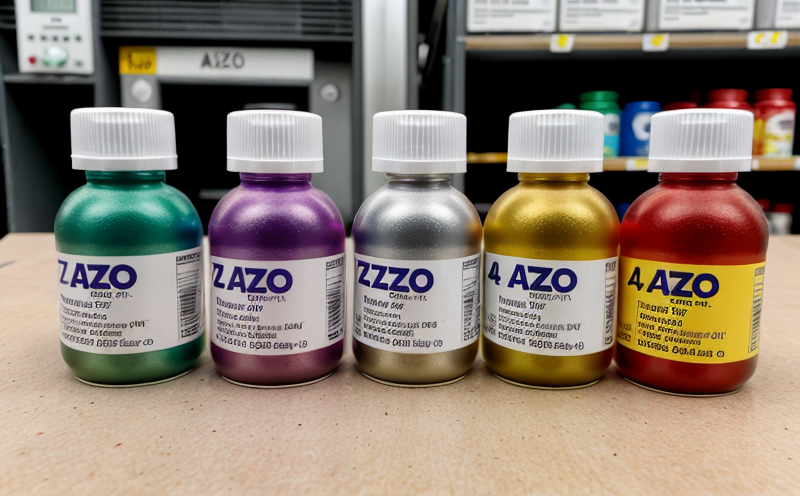GB T 17592 Determination of banned azo colourants in textiles
The GB/T 17592 standard is a crucial guideline that ensures textile products are free from harmful banned azo dyes. This method is widely used for the determination and detection of these potentially toxic substances. The primary objective of this testing procedure is to safeguard public health by preventing exposure to hazardous chemicals. By adhering to this standard, manufacturers can ensure their products meet stringent quality and safety requirements.
The process involves several steps that are critical in accurately determining whether a textile contains any prohibited azo dyes. Specimen preparation plays a pivotal role; it requires precise handling and processing of the fabric samples to ensure accurate results. After preparing the samples, extraction techniques are employed to release any azo compounds present within the textiles. This step is essential as it allows for effective analysis using subsequent analytical methods.
Once extracted, the samples undergo quantitative analysis which typically involves gas chromatography-mass spectrometry (GC-MS). This sophisticated technique provides highly accurate and precise measurements of the concentration levels of various azo dye components in the textile. It's important to note that only certain types of azo dyes are considered hazardous under this standard; therefore, understanding these specific compounds is crucial for interpreting results correctly.
Compliance with GB/T 17592 also involves rigorous quality assurance measures throughout every stage of production and testing. These include strict adherence to prescribed procedures, regular calibration of equipment used in analyses, and continuous monitoring of environmental factors that could affect the integrity of samples during transit or storage. Additionally, ongoing training for personnel involved ensures they remain up-to-date with any changes in standards or emerging threats related to azo dyes.
Furthermore, this testing procedure contributes significantly towards maintaining high levels of reliability when it comes to ensuring compliance with international regulations concerning textile safety and environmental sustainability practices. The stringent nature of GB/T 17592 helps maintain consistency across different batches of textiles produced by various manufacturers globally, thereby fostering trust among consumers who rely on such products daily.
The importance of this standard cannot be overstated; it serves as both a protective measure for individuals exposed to potentially harmful substances and an assurance mechanism for businesses that want to demonstrate their commitment to responsible manufacturing practices. Through meticulous application of GB/T 17592, textile producers can continue providing safe products while adhering to global standards set forth by regulatory bodies.
Understanding the intricacies behind this standard helps stakeholders appreciate its significance in maintaining public health and promoting sustainable business operations within the industry. With increasing awareness about chemical hazards associated with certain dyes, there is growing demand for more stringent testing procedures like those outlined in GB/T 17592.
Why It Matters
Banned azo colourants are prohibited due to their potential toxicity and carcinogenic properties. These compounds can leach out from textiles during wear or washing processes, posing health risks when they come into contact with human skin. The GB/T 17592 standard ensures that these harmful substances do not reach the market, protecting consumers' well-being.
Compliance with this standard is particularly important for businesses operating in competitive markets where reputation and trust are paramount. By demonstrating adherence to recognized safety protocols like GB/T 17592, companies can enhance their credibility among customers and stakeholders alike. This transparency fosters long-term relationships built on reliability and integrity.
Moreover, compliance with such standards supports broader efforts toward environmental sustainability by discouraging the use of environmentally unfriendly materials that may harm ecosystems over time if improperly managed throughout their lifecycle. Adopting practices aligned with GB/T 17592 contributes positively to reducing waste generation and promoting cleaner production methods across industries.
For quality managers, compliance officers, R&D engineers, and procurement professionals involved in textile manufacturing processes, understanding the significance of GB/T 17592 is essential. It provides a framework for implementing effective measures aimed at minimizing risks associated with banned azo colourants while ensuring product safety standards are met.
Quality and Reliability Assurance
- Precision of Measurements: The use of advanced analytical techniques such as gas chromatography-mass spectrometry (GC-MS) ensures highly accurate quantification of azo dye concentrations in textile samples.
- Consistent Results: Rigorous quality control measures ensure consistent outcomes across multiple batches and different production runs, enhancing overall reliability of the testing process.
Regular calibration of equipment used during analysis helps maintain precision throughout the entire testing cycle. This is critical for obtaining reliable data that can be relied upon when making decisions regarding product safety and compliance.
In addition to technical accuracy, maintaining detailed records of all test procedures and findings allows for easy traceability should any discrepancies arise later on. Such transparency fosters confidence among clients and regulatory authorities alike who rely on consistent, reproducible results from laboratories performing such tests.
Environmental and Sustainability Contributions
- Eco-friendly Production: By ensuring that textiles are free from banned azo dyes, GB/T 17592 supports sustainable production practices by reducing the environmental impact associated with the use of harmful chemicals.
- Reduction in Waste: Minimizing exposure to hazardous substances through rigorous testing helps prevent contamination during textile processing and disposal stages, contributing to waste reduction efforts.
The standard plays a vital role in promoting responsible manufacturing by encouraging the adoption of safer alternatives that are not only beneficial for human health but also environmentally friendly. This shift towards greener practices aligns with broader goals set forth by international organizations dedicated to sustainability and responsible consumption.
Through continuous improvement and adherence to strict quality assurance protocols, laboratories specializing in GB/T 17592 testing contribute significantly to the ongoing efforts aimed at protecting both people and planet from harmful effects caused by non-compliant textiles.





